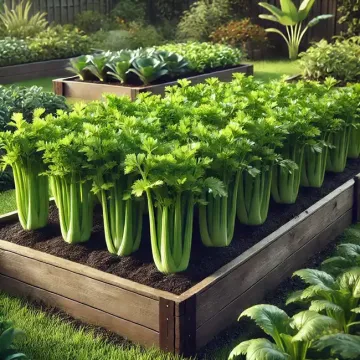Celery is a versatile vegetable known for its crisp texture and unique flavor. Whether used in soups, salads, or as a healthy snack, celery is a staple in many kitchens. While celery has a reputation for being challenging to grow, with the right knowledge and care, it can thrive in a home garden. This article will cover the history of celery, its health benefits, culinary uses, and tips for growing it successfully at home.
History of Celery
Celery has been cultivated for thousands of years, originating in the Mediterranean regions. Ancient civilizations, including the Egyptians, Greeks, and Romans, valued celery not only as food but also for its medicinal properties. In the Middle Ages, celery was primarily used for its therapeutic benefits, believed to help with digestion and inflammation. It wasn't until the 17th century that celery began to be widely cultivated as a food crop in Europe. Today, it remains a popular vegetable around the world.
Health Benefits of Celery
Celery is a low-calorie vegetable packed with essential nutrients. It is an excellent source of dietary fiber, which aids digestion and supports heart health. Celery is also rich in vitamins A, C, and K, as well as potassium and folate. Its high water content makes it hydrating, and its natural antioxidants help reduce inflammation and protect against disease. Celery is often recommended in weight loss diets due to its low calorie and high fiber content, which promotes satiety.
Culinary Uses of Celery
Celery is incredibly versatile in the kitchen. Its crisp, refreshing stalks are commonly used in salads, while the leaves add flavor to soups and stews. Celery can be eaten raw, often paired with dips or peanut butter, or cooked to enhance the flavor of broths, stuffing, and casseroles. Celery is also an essential ingredient in the classic mirepoix—a mixture of celery, onions, and carrots—used as a base in many soups and sauces. Additionally, celery seeds are often used as a spice, particularly in pickling and seasoning blends.
Growing Celery at Home
Growing celery requires patience and attention to detail, but it can be a rewarding addition to your home garden. Here are some key tips to help you grow healthy celery:
- Climate and Timing: Celery thrives in cool weather, making it a suitable crop for spring or fall. It requires a long growing season of about 16-18 weeks of cooler temperatures, ideally between 60-70°F (15-21°C). In warmer climates, consider starting seeds indoors and transplanting them outdoors after the danger of frost has passed.
- Soil Preparation: Celery prefers rich, well-draining soil with a pH between 6.0 and 7.0. To ensure healthy growth, amend the soil with plenty of compost or well-rotted manure to provide essential nutrients and retain moisture. Celery is a heavy feeder, so a nutrient-rich soil is crucial for optimal growth.
- Sowing and Transplanting: Celery seeds are small and slow to germinate, so it's best to start them indoors 10-12 weeks before your last expected frost date. Sow the seeds in seed trays, covering them lightly with soil. Once the seedlings are about 2 inches tall, they can be transplanted into the garden, spaced about 6-8 inches apart.
- Watering: Celery has shallow roots and requires consistent moisture to prevent the stalks from becoming tough and stringy. Ensure the soil remains evenly moist by watering regularly. Mulching around the plants can help retain soil moisture and prevent weeds.
- Fertilization: Since celery is a heavy feeder, it benefits from regular feeding. Apply a balanced fertilizer every 2-3 weeks, focusing on providing nitrogen to encourage leaf and stalk growth. Organic fertilizers, such as fish emulsion or compost tea, are excellent choices for celery.
- Blanching and Harvesting: Blanching is the process of covering the celery stalks to protect them from the sun, resulting in paler, more tender stalks. You can do this by loosely wrapping the stalks with paper or using boards to block sunlight. Harvest celery when the stalks reach about 8 inches in height, cutting them at the base. Celery can be harvested throughout the growing season, or you can harvest the entire plant at once.
Pest and Disease Management
Celery is susceptible to pests such as aphids, slugs, and celery worms. To minimize pest issues, practice crop rotation and companion planting. Beneficial plants like marigolds, nasturtiums, and dill can help repel common pests. Keep an eye out for signs of disease, such as leaf spot or early blight, and remove any affected plants promptly to prevent the spread of infection.
Growing celery in the home garden can be a bit of a challenge, but with proper care and attention, it can reward you with crisp, flavorful stalks. By providing the right climate, soil conditions, and consistent care, you can enjoy the satisfaction of harvesting your own homegrown celery. Whether you’re adding it to soups, salads, or simply enjoying it as a snack, fresh celery from your garden will elevate your culinary creations and provide a nutritious boost to your meals.

